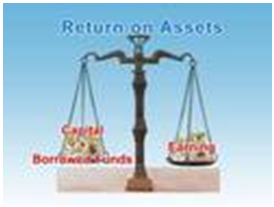Investors often look for the magic number or metric that will identify a great stock out of the universe of all stocks. This magic number doesn’t exist.
However, when you are considering stocks to buy, there are certain metrics and numbers that are more important than others. They can’t be used as the sole qualifier to determine great stocks, but you can use them to eliminate poor performers. One such metric is Return on Assets.

What is ROA?
Return on Assets (ROA) is an indicator of how profitable a company is relative to its total assets. ROA gives an idea as to how efficient management is at using its assets to generate earnings. Calculated by dividing a company's annual earnings by its total assets, ROA is displayed as a percentage. Sometimes this is referred to as "Return on Investment". (ROI)
The formula for return on assets is:= Net Income
Total Assets
Note: Some investors add interest expense back into net income when performing this calculation because they'd like to use operating returns before cost of borrowing.
Meaning of ROA
ROA tells you what earnings were generated from invested capital (assets). ROA for public companies can vary substantially and will be highly dependent on the industry. This is why when using ROA as a comparative measure, it is best to compare it against a company's previous ROA numbers or the ROA of a similar company.
The assets of the company are comprised of both debt and equity. Both of these types of financing are used to fund the operations of the company. The ROA figure gives investors an idea of how effectively the company is converting the money it has to invest into net income. The higher the ROA number, the better, because the company is earning more money on less investment.
Significance of ROA
· ROA tells what the company can do with what it has, i.e. how many dollars of earnings they derive from each dollar of assets they control. It's a useful number for comparing competing companies in the same industry.
For example, if one company has a net income of Rs 1 million and total assets of Rs 5 million, its ROA is 20%; however, if another company earns the same amount but has total assets of Rs 10 million, it has an ROA of 10%. Based on this example, the first company is better at converting its investment into profit. When you really think about it, management's most important job is to make wise choices in allocating its resources
· ROA shows how companies have two choices in improving efficiency.
o Companies can raise prices and create high margins or rapidly move assets through the company. Either way (or both) improves ROA.
Limitations of ROA
· Falling ROA is almost always a problem, but investors and analysts should bear in mind that the ROA does not account for outstanding liabilities and may indicate a higher profit level than actually derived
· ROA is an important measure to use and understand, but its flaw is that the metric does not consider the effect of borrowed capital.
Things to Remember
- The ROA is often referred to as ROI
- The number will vary widely across different industries, but in general, the higher the ROA the better.
- Return on assets gives an indication of the capital intensity of the company, which will depend on the industry; companies that require large initial investments will generally have lower return on assets. ROAs over 5% are generally considered good.
We will explain other Ratios likeReturn on Capital Employed (ROCE)which Fund Managers usually use while evaluating stocks in the next edition on Mirae Asset Knowledge Academy Tutorials.
Mutual fund investments are subject to market risks, read all scheme related documents carefully.




